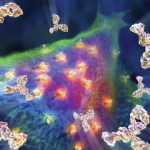Anti-citrullinated protein antibodies (ACPAs) are now viewed as critical diagnostic and prognostic markers for rheumatoid arthritis (RA). Research into the pathophysiology of these autoantibodies has proven to be a ripe area of investigation, opening up many promising avenues for better understanding the etiology and pathogenesis of RA. Ultimately, work utilizing these autoantibodies may also allow for earlier interventions in patients likely to develop RA. Here, we trace the beginnings of our understanding of these autoantibodies from work done in the 1960s by the Dutch physicians Roelof Nienhuis and Enno Mandema.1
Early Autoantibody Research
V. Michael Holers, MD, is the Scoville Professor and head of the Rheumatology Division at the University of Colorado School of Medicine, Denver. He describes the seminal work performed in the 1940s, ’50s and beyond, as scientists learned they could identify novel autoantibody patterns via the development of fluorescent antibody testing methods. To detect potential autoantibodies, these immunofluorescence techniques used tissue culture or primary cells as the antigenic substrate.2
This work led to the detection of autoantibodies linked to various autoimmune diseases, including systemic lupus erythematosus, scleroderma and dermatomyositis. Importantly, it was found that disease-associated autoantibodies produced distinct patterns of staining on cellular substrates and tissues, because they reacted with specific antigens in different compartments inside or outside cells. Ultimately, it became clear that certain autoantibodies were disease specific, but others were not, and that multiple autoantibodies of different specificities may characterize an individual autoimmune disease.2

Dr. Holers
Dr. Holers explains, “This era was characterized in many different fields of medicine by efforts to link the presence of a syndrome that you would define by its clinical features to an immune-based test. This included looking at the target tissue to see whether there were antibodies there and assessing if patient sera reacted with normal or diseased tissues.” As one example, scientists identified antibodies in rheumatoid arthritis synovium and began to characterize them. Dr. Holers notes, “Studies in RA began in that context and in an era in which scientists were trying to come up with specific tests that could help with classification and treatment.”
In 1940, Erik Waaler, MD, reported an antibody in the serum of a patient with RA that promoted the agglutination of sheep red blood cells. Eventually, these were shown to be a class of immunoglobulins that recognized the Fc (fragment crystallizable) immunoglobulin tail, though they possessed different isotypes and affinities. In 1952, these were named rheumatoid factors (RFs) because of their association with rheumatoid arthritis.3 This was eventually developed into a commonly used diagnostic test for RA. However, RF is a fairly non-specific marker for rheumatoid arthritis; it can appear in people with many other chronic conditions, as well as in people who appear healthy, especially in the elderly.4

